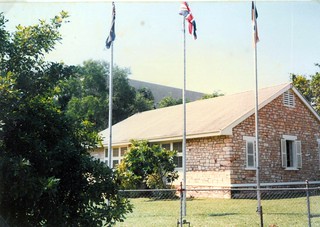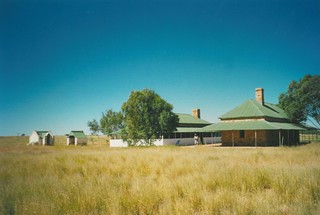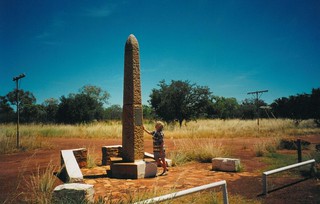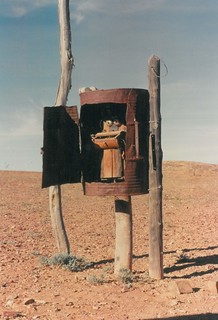In July 1997 I followed in the footsteps of some of our early telecommunications pioneers. Arriving in Darwin I first went on a ‘pilgrimage’ to the exact spot where the first undersea cable left Australia linking our country with the rest of the world. With the first international message sent on October 21st 1872 communication time between Australia and Europe was reduced from 3 months to 7 hours. Through thirteen repeaters messages were transmitted in Morse code.
From Darwin the cable went undersea to Batavia (Djakarta) on the Indonesian Island of Java. At that stage the Dutch Colonial Telecommunications Authorities looked after the link to Singapore and from there on to the UK via India, Aden, Malta and Gibraltar. Close to the cable landing point in Darwin is the historic British Australian Telegraph (BAT) house; the official name was “Eastern Extension Australasia and China Telegraph Company, but BAT was the name used by everyone in Darwin (and the rest of Australia). BAT house was built in 1925 for the Darwin Cable Company, the organisation in charge of the maintenance of the cable.
First international link: Darwin-Batavia(Djakarta)-Singapore-Penang-Madras-Bombay-Aden-Suez(Alexandria)-Malta-Gibraltar-Falmouth(UK)-London
Before Australia could be linked, however, the telegraph systems that were in operation in the southern States (see box) had to be connected with the planned undersea cable. An overland telegraph had been on the planning boards of the South Australian Colonial Government since the 1860s. Explorer John McDouall Stuart was asked to find an overland route for a proposed line.
There was severe competition between the colonies of Queensland and South Australia (the latter had annexed the Northern Territory for this purpose in 1863) and after three attempts Stuart made it to Darwin and reported that it was easy to build a straight overland line.
In 1871 under the stewardship of (Sir – since 1892) Charles Todd, SA Superintendent of Telegraphs, the route was surveyed by John Ross. One of his team mates, William Whitfield Mills, named Alice Springs after Lady Alice Todd and the river running through the town was named the Todd River.
Three parties started building the Overland Telegraph. The first telegraph pole was erected in Darwin in September 1870. After eight months of delays the lines parties finally met midway between Tennant Creek and Katherine and the lines were linked on the 22nd of August 1872. The spot is marked with a small monument and a couple of old telegraph poles, where I, of course, took some pictures (see below).
The thirty thousand poles were eaten by termites. Porcelain insulators proved to be ideal material for aboriginal spearheads and other tools.

In all 36,000 (timber) poles were needed to cover the 3178 kilometres. A single iron wire provided one-way communications, 4 hours in one direction followed by 4 hours in the other direction and so on. The timber poles were quickly eaten by the termites and within three years most of them had to be replaced with iron poles. In 1898 a second (copper) wire was strung to facilitate the rapidly increasing traffic. However, it was not until 1926 that the infrastructure was also used for telephony. In 1942 the undersea cable was cut to prevent the use of the system by the enemy. This historic (international) telegraph link was never restored after the war. By then more modern methods of communication had made this technology obsolete.
Court House: Car Repairs; Hotel; Telemedicine in Morse code!
From Darwin I drove by car to Alice Springs. The old telegraph line between Darwin and Katherine was replaced by a fibre optic cable in 1985. Very appropriately, this was the first fibre optic telecommunications trunk line in Australia. In the very pleasant and multicultural town of Katherine I stayed in the Knotts Crossings Hotel, approximately 3 kilometres east of the current township.
It was here that the Overland Telegraph (OT) crossed the river that also runs through the beautiful Katherine Gorge. Like so many places along the OT, Knotts Crossing quickly became the focus point for a range of other activities. Repeater stations became the places for all official (Government) business in the area and provided accommodation for passing travellers.
The linesmen on the OT had to be Jacks-of-all-trades and workshops were erected with, amongst other things, blacksmith facilities. These workshops were also called upon by the early pioneers and stockmen travelling through this inhospitable country under the OT wires. The linesman of each section checked approximately 250 kilometres of wire on horseback; this meant that sometimes the lines were down for weeks. The porcelain insulators, for example, proved to be excellent materials for the aborigines to make spearheads and other stone tools!! Some of the linesmen’s workshops grew into garages.
In 1895 OT staff provided the support to the first cyclist who crossed the Australia by bicycle and the same applied to the first overland car trip in 1907.
Post Office activities were amongst many of the other facilities provided by OT stations. The Post Master in Alice Springs was the only Government official in an area of thousands of square kilometres and was policeman, chief justice, and represented the King or Queen, Governor or Government. In the early years the telegraph could only be used for Government purposes and the Post Master was the only one who could overrule this in an emergency – for example, a serious illness that had to be discussed with doctors in Adelaide. The Australian Post Masters were amongst the first to use the new system for telemedicine purposes as there was no medical doctor available between Adelaide and Darwin. All medical support had to be provided via the telegraph – in Morse code! The very strict privacy rule that applied to all telegraphists was breached once, when the Post Master in Alice informed his wife that Queen Victoria had died!
Another historic place is the repeater station in Tennant Creek, currently situated 13 kilometres north of the town, was the major settlement in the area until gold was discovered in the 1930s and mining started. The focus of activity moved on to where the township is currently situated. The site and the buildings are preserved and the NT Parks and Wildlife Commission, who is now looking after this place, is canvassing for suggestions from visitors as to what to do with the site. I put in my two bob’s worth of comments in the visitors book, suggesting a restoration of the telecommunications facilities.

Telecommunications milestones since 1853
In 1853 the Victorian Government issued a tender for a telegraph network between Melbourne and Williamstown. The system was built in 1854. In the ensuing years similar systems were set up in the other colonies. The famous Overland Telegraph link from Adelaide to Darwin was finished in 1872 and from here an undersea cable to Batavia (now Djakarta) on the Indonesian Island of Java. From here Australia was linked to Europe.
In 1880 the first private telephone exchange opened in Melbourne (only a few years after Alexander Graham Bell – who visited Australia in 1910 – had invented the telephone in 1876). Geelong was the first city in Australia, and indeed in the southern hemisphere, to get an automated public exchange in 1912. STD arrived in 1966 and ISD ten years later. The first microwave network was built between Melbourne and Bendigo in 1959. The first coax cable followed in 1962, between Sydney and Melbourne and fibre optic arrived in 1985 with a link between Darwin and Katherine.

From Tennant Creek it was on to The Alice.
A few hundred kilometres outside Tennant Creek I visited the repeater station at Barrow Creek, still in pristine condition. The Alice, of course, is the most famous town that owns its start to the OT. The repeater station, 3km north of the current town at the billabong in the Todd River, became the first settlement. Until 1880, the telegraph station was the only reason for the existence of the settlement. Then gold was discovered in the area and later on the development of another infrastructure project, the Ghan Railway from Adelaide to Alice, increased activity in the area.

For a couple of hundred kilometres south of Katherine and from Tennant Creek, the original poles of the OT are still providing the telecommunication link, but from here on wires are replaced with microwave transmission. Every 40 kilometres a telecommunication mast towers above the desert, for hundreds of kilometres they are the only man-made structures in the landscape – now not only linking Adelaide (Port Augusta) and Darwin, but also forming the trunk network for Telstra’s Digital Radio Concentrator System (DRCS) for rural, remote and aboriginal people in this part of Australia.

DRCS: The new OT
A major network program, unique in the world was launched in 1984 under the name Rural and Remote Areas programme. The $530 million project aims to provide modern telecommunications to outback Australia. The project included, amongst other things, the upgrading 26,000 lines that were still linked to manual exchanges. Over 10,000 of these links were privately owned and had been in use for decades.
The Middleton Phone Company (Qld) was established in 1914 by local graziers linking their 160km (mainly fence-wire) system strung on trees and poles into the local exchange in Milton. The largest of such systems was from Lucknow Station in western Queensland to the exchange in Winton, covering a distance of 200km. The last manual exchange, in Wanaaring, 190km north-west of Bourke NSW, was ‘cut over and killed’ in December 1991.

At the core of the new network is Telstra’s Digital Radio Concentrator System (DRCS), developed in-house by the Telstra Laboratories. Radio signals are beamed in concentrated bursts from remote customers to the nearest exchange where the calls enter the national network. The (solar powered) repeaters are 40-50km apart and up to 13 of them can be used, providing links to a maximum of 600km. The longest and most expensive link ($3 million) was the installation of the network to Kiwirrkurra, an Aboriginal community in Western Australia’s Gibson Desert. On average DRCS installations cost $20,000. Telstra charges a fee of $1501 for new customers and $624 for existing customers. By the year 2000 the system will also be able to offer fast digital services based on ISDN.
After travelling some 2,900km through ‘our own Territory’ I decided that I had to come back again to follow our early telecommunications heroes on the South Australian side of the border. During this trip I was truly inspired by these early pioneers and I once again felt proud and honoured to be a part of this exciting industry.
Paul Budde
In 2017 I received the prestigious Charles Todd Medal for my contribution to the Australian telecommunications Industry. To my right is Charles’ great-grandson Barry, to my left Professor Denis Cryle, the author of “Behind the Legend. The many worlds of Charles Todd”.

Our June 2024 Adam Courtenay presenting at the Ciy of Sydney Historical Society told the fascinating story of Mr Todd’s Marvel. Charles Todd had a dream to build a telegraph line across Australia to connect it to the world and he achieved it well before modern technology as we know it. We take so much for granted today in communication and travel and it has been forgotten just how long it took to send a letter ‘home’ and receive an answer. Other than the very wealthy, most European settlers never saw their families again. The Overland Telegraph line changed this forever. Scroll down to the article in the downloadable pdf below.
Downloadable pdf: Overland Telegraph
See also : Various: Netherlands, Australia, Travelogues